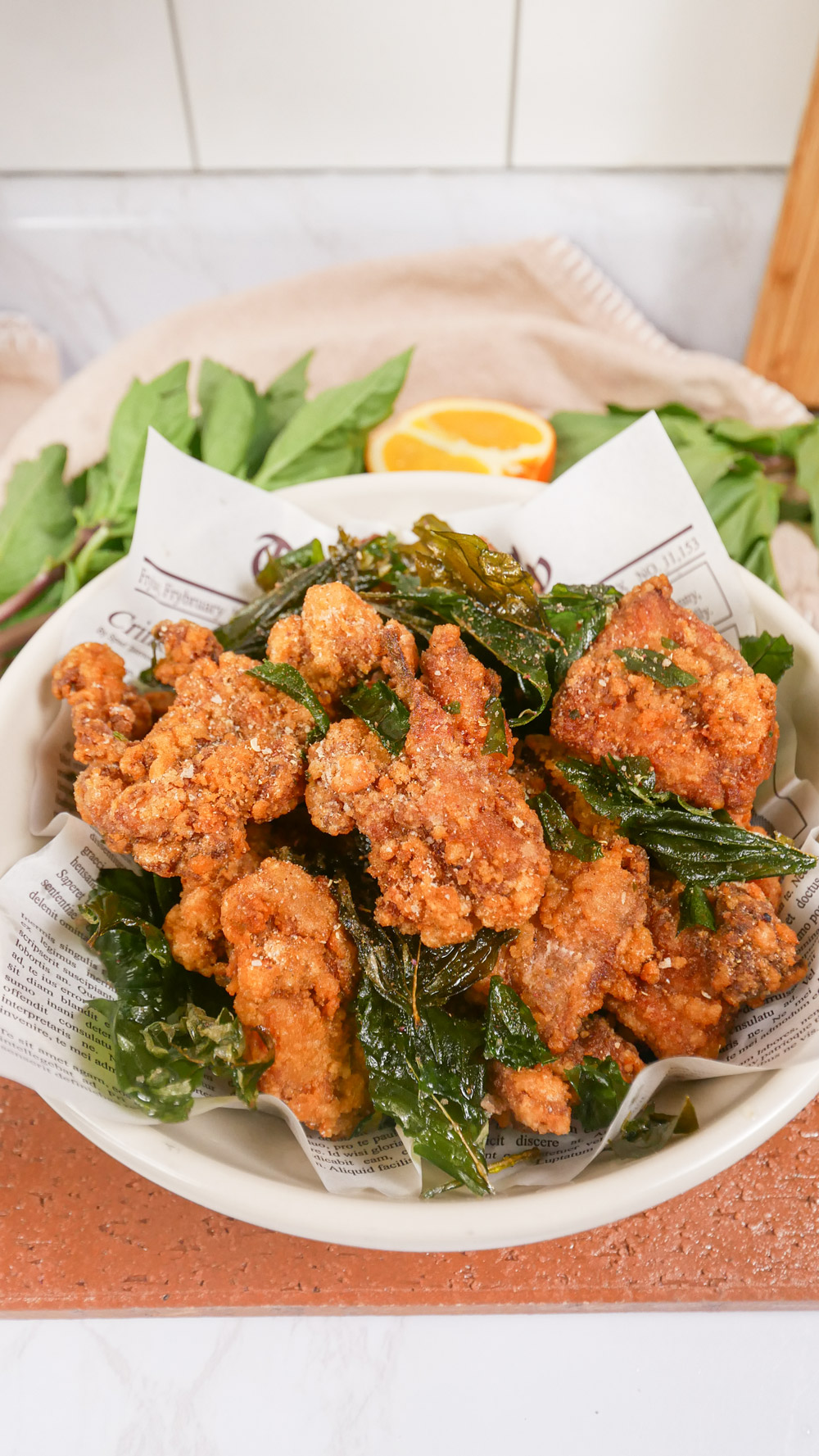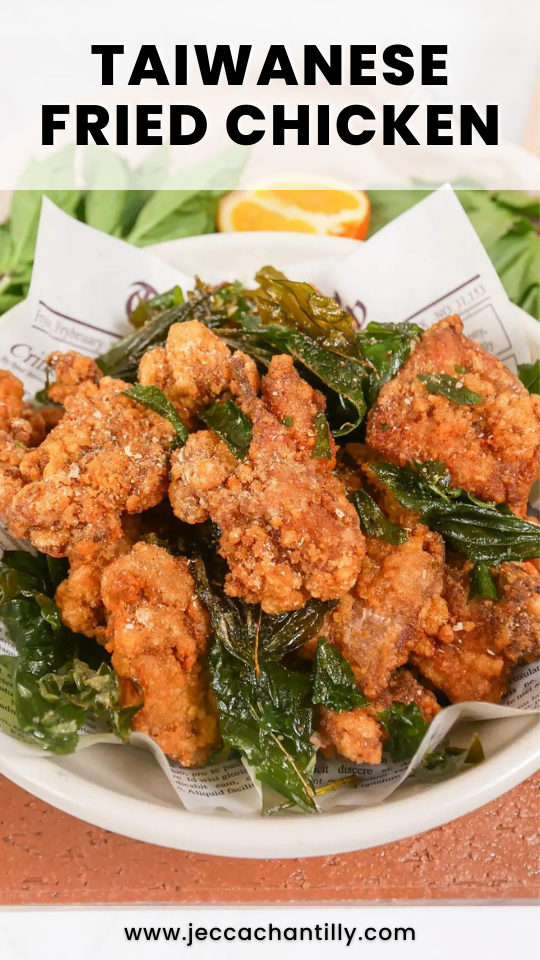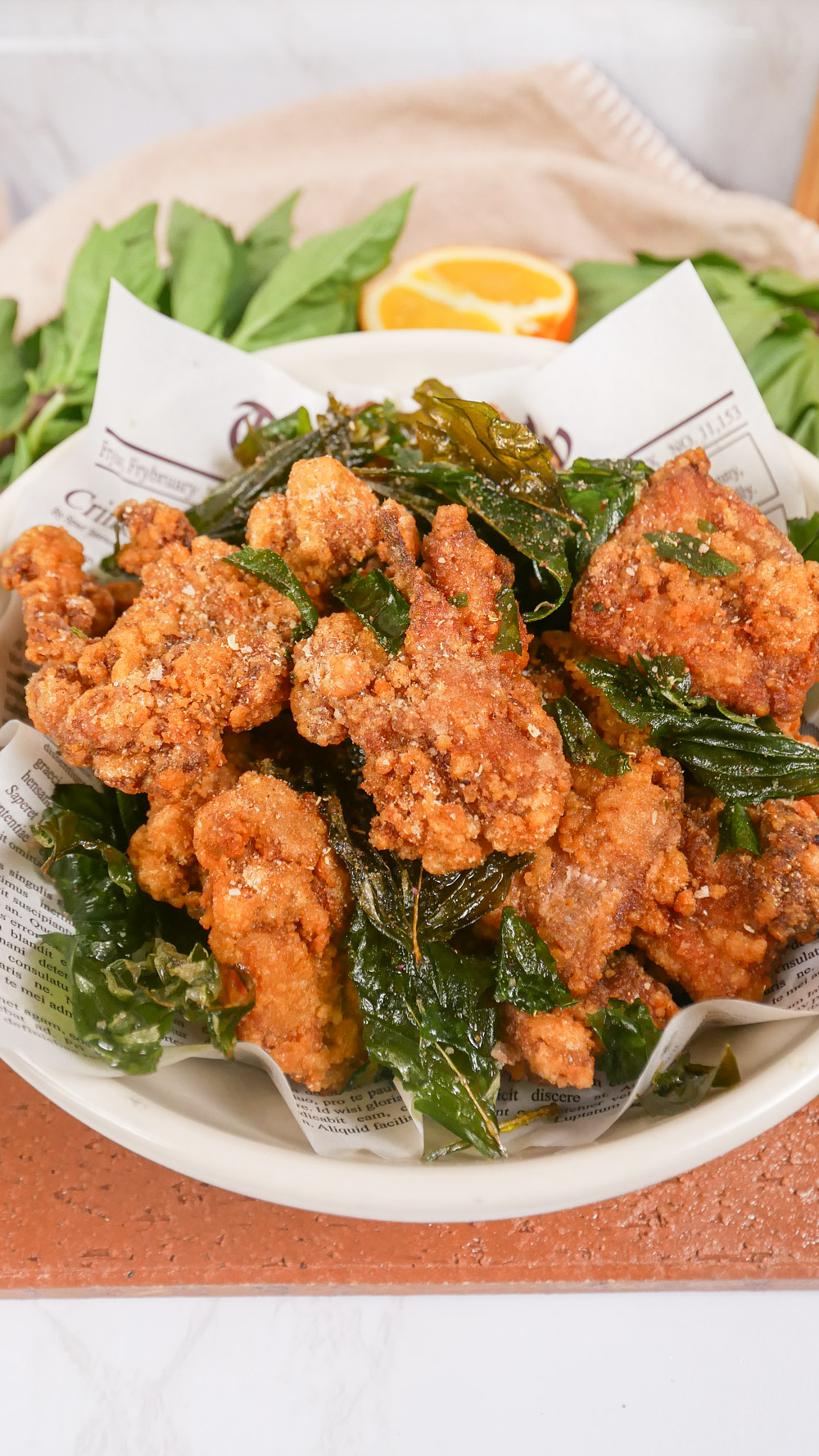Taiwanese fried chicken or ‘yan su ji’ is a popular street food originating from Taiwan. They’re bite-size pieces of chicken, similar to popcorn chicken, which is marinated and coated in batter and then deep-fried to golden perfection. The result is a crispy and juicy fried chicken bursting with flavors and textures. It’s the ultimate comfort food, and delicious snack to satisfy your fried chicken cravings.
Why you’ll love this recipe
Taiwanese fried chicken is in a league of its own due to its unique flavor profile and texture. And the secret to a flavorful bite is the marinating process! While there are many variations of Taiwanese fried chicken, my recipe for the marinade includes soy sauce, cooking wine, garlic, various spices, and a secret ingredient – freshly squeezed orange juice, giving it a depth of flavor that’s savory, spicy, and subtly sweet. To finish it off, a homemade Sichuan-white peppercorn seasoning is used to season the hot chicken as it comes out of the fryer.
Now onto the coating, it consists of tapioca starch which creates an incredibly crispy exterior that has the ultimate crunch. Tapioca starch has low gluten content, which allows for the chicken to have a light and addictively good, and slightly chewy crust.
For the final touch, flash-fried Thai basil is served with the chicken for additional crunch and flavor. Next time you’re craving a delicious fried chicken, give this recipe a try!
How do I prepare Taiwanese Popcorn Chicken?
Follow the easy step-by-step recipe below to prepare this crispy and juicy fried chicken dish at home:
Step 1: Slice the chicken
Cut the chicken thighs into 1 ½ -inch thick pieces.
Step 2: Marinate the chicken
Combine the chicken thighs, grated garlic, soy sauce, Shaoxing cooking wine, orange juice, sugar, Chinese five spice powder, white pepper, and 1 teaspoon of salt in a bowl. Mix well and marinate for at least 1 hour or overnight.
Step 3: Toast the peppercorns
Heat a small skillet over medium heat and combine Sichuan peppercorns and white peppercorns (if using whole). Toast for 2 to 3 minutes, constantly stirring to prevent the spices from burning. Remove and transfer to a spice grinder or mortar and pestle. Grind into a powder or your desired coarseness. Transfer to a bowl with 1 teaspoon of salt and 1 teaspoon of sugar. Mix, then set aside for later.
Step 4: Pre-heat the oil
Fill a medium-sized pot with neutral oil about halfway up. Heat over medium heat to 350°F or 175°C.
Step 5: Coat the chicken
Toss the chicken along with any juices in the bowl with tapioca flour. Add about 1 teaspoon of water to form small beads around the chicken.
Step 6: First fry the chicken
For the first fry, carefully place the battered chicken into the hot oil and fry for about 2 minutes or until golden brown. Be sure to work in batches to avoid overcrowding the pot. Transfer the fried chicken to a wire rack or plate lined with a paper towel. Repeat until all the chicken is fried.
Step 7: Second fry the chicken
For the second fry, raise the oil temperature to 400°F or 205°C. Working in batches again, carefully place the fried chicken into the oil and fry for 1 minute until golden brown and crispy. Remove immediately, then sprinkle the Sichuan-white peppercorn seasoning over the chicken. Repeat for the remaining chicken.
Step 8: Fry the Thai basil
Pat the Thai basil leaves completely dry before adding to the hot oil. Carefully add the Thai basil and fry for 1 to 2 minutes or until they’re crispy. Be sure to have a lid or splatter screen ready because the Thai basil will cause the oil to splatter vigorously! Remove, then serve with the fried chicken. Sprinkle a little more Sichuan-white peppercorn seasoning on top, and enjoy!
Cooking Tips for Taiwanese Popcorn Chicken
To make the most delicious Taiwanese fried chicken every single time, here are a few cooking tips you can keep in mind:
- The fresh orange juice in the marinade helps to tenderize the meat and add a subtle citrusy flavor.
- The longer the chicken marinates, the more flavorful and tender it will be. I highly recommend marinating it overnight if you have the time and patience! If not, allow the chicken to marinate for at least one hour.
- When tossing in the tapioca starch (or potato starch), you want to see small little clusters of starch coat the chicken, which is what makes it extra crunchy. To create these beads, add a few drops of water at a time to help form the clusters. Be sure to press the coating onto the chicken so it adheres better.
- Double frying is key to the crispiest and crunchiest fried chicken, so don’t skip this step!
- Strain any floating bits of coating out of the oil between each batch fry to prevent them from burning.
- Please be extra careful when frying the Thai basil. Hot oil will splatter as the Thai basil releases water. I recommend using a lid or splatter screen when frying the herb.
Ingredients & Substitutions
Chicken thighs: For juicy and foolproof Taiwanese fried chicken I used skinless and boneless chicken thighs for this recipe. You can also use chicken breast but it won’t be as juicy.
Garlic cloves: garlic cloves add a garlicky taste and aroma to the marinade. Feel free to use more but not less!
Soy sauce: soy sauce is used to season the chicken marinade. I prefer using Pearl River Bridge Superior Light Soy Sauce.
Shaoxing cooking wine: or Chinese cooking wine is added to tenderize the meat and eliminate any odors. It also adds a subtle sweetness to the marinade. This can be substituted with dry sherry, mirin, or sake.
Fresh orange juice: the acidity of fresh orange juice helps tenderize the chicken and add a hint of citrusy flavors to the marinade. You can substitute it with lemon or pineapple juice.
Salt: salt is used to season the dish. Feel free to adjust according to your taste.
Sugar: sugar helps to balance out the salty and savory flavors in the dish. I recommend using white sugar or cane sugar for this recipe.
Chinese five spice powder: Chinese five spice powder adds a combination of sweet, bitter, sour, salty, and savory flavors to the marinade. There are many variations and combinations of spices used to make Chinese five spice powder and the most commonly used spices include Chinese cinnamon, cloves, fennel seeds, and Sichuan pepper. Depending on the region, some blends include Mandarin orange peel. If you don’t have a Chinese five spice powder blend, you can make your own by grinding and mixing the spices mentioned above.
White pepper: white pepper adds a subtle spice and floral note to the fried chicken. While I used whole white peppercorns, you can also use ground white pepper.
Tapioca flour: tapioca flour is essential for creating the light, chewy, crispy, and crunchy coating that Taiwanese fried chicken is known for. You can also use sweet potato starch as a substitute.
Thai basil leaves: the spicy and peppery flavor of the Thai basil leaves completes the dish. If you don’t have Thai basil, you can simply omit them however, it’s not the same without it!
Neutral oil: be sure to use a neutral oil with a high smoke point like canola, vegetable, and avocado oil.
Sichuan peppercorn: Sichuan peppercorn provides a citrusy flavor and numbing sensation as a final touch to the dish.
Frequently Asked Questions
What does Thai basil taste like?
Thai basil has a distinct spicy, savory, and anise-like flavor, making it the perfect companion for Taiwanese fried chicken. Frying them gives them a crispy consistency, making them more enjoyable to eat!
Can I make Taiwanese Fried Chicken in an air fryer?
Yes, absolutely! It’s a healthier alternative to frying and almost identical in taste and texture. Check out my easy and delicious Air Fryer Taiwanese Popcorn Chicken recipe!
What can I use if I don’t have Chinese five-spice powder?
There are many variations of Chinese five-spice powder and you can make it easily at home by grinding and mixing together Chinese cinnamon, cloves, fennel seeds, star anise, and Sichuan pepper. For a more intense flavor, toast the spices in a pan before grinding.
Can I use chicken breasts instead of chicken thighs?
Yes, absolutely! While I prefer using chicken thighs for their juiciness and flavor, chicken breast is a great substitute. Just be careful not to overcook the chicken if using breast meat as it can become dry.
How can I store Taiwanese fried chicken?
Taiwanese fried chicken is best enjoyed fresh however if you need to store it, store it in an air-tight container in the fridge for up to 2 days. Reheat the chicken by deep frying or air frying at 375F or 190C for 1 to 2 minutes.
Looking for more easy & delicious Taiwanese-inspired recipes?
1. Pork Belly Bao – aka ‘gua bao’ is a rich and savory pork belly bao that is insanely delicious. It has the perfect combination of salty, sweet, and spicy – and I promise you’ll be hooked after just one bite!
2. Fried Chicken Bao – these Taiwanese fried chicken baos served with delicious Thai basil aioli are seriously life-changing. The sauce is creamy, tangy, and a little spicy, and goes perfectly with the crispy chicken and fluffy bao.
3. Taiwanese Sesame Noodles (Ma Jiang Mian) – this sweet and savory noodle recipe is the perfect 10-minute meal for any day of the week!
4. Taiwanese Three Cup Chicken (San Bei Ji) – aka ‘san bei ji’, is a Taiwanese staple and one of my favorite dishes! The flavorful sauce coupled with the tender and juicy chicken make it the perfect 30-minute weeknight meal.

Taiwanese Style Fried Chicken
Ingredients
- 1 lb boneless & skinless chicken thighs (3 to 4 thighs)
- 4 garlic cloves grated
- 1 tbsp soy sauce
- 1 tbsp Shaoxing cooking wine
- 1 tbsp fresh orange juice
- 1 tsp salt
- 1 tsp sugar
- 1 tsp Chinese five-spice powder
- 1 tsp white pepper ground
- 1 cup tapioca flour or potato starch
- 1 cup Thai basil leaves washed and pat dry
- 6 cups neutral oil for frying
Sichuan-White Peppercorn Seasoning
- 1 tsp Sichuan peppercorn ground
- 1 tsp white pepper ground
- 1 tsp salt
- 1 tsp sugar
Instructions
- Cut the chicken thighs into 1 1/2 inch thick pieces.
- In a bowl, combine the chicken thighs, grated garlic, soy sauce, Shaoxing cooking wine, orange juice, sugar, Chinese five spice powder, white pepper, and 1 teaspoon of salt. Mix well and marinate for at least 1 hour or overnight.
- Heat a small skillet over medium heat and combine Sichuan peppercorns and white peppercorns (if using whole). Toast for 2 to 3 minutes, making sure to constantly stir to prevent the spices from burning. Remove and transfer to a spice grinder or mortar and pestle. Grind into a powder or your desired coarseness. Transfer to a bowl with 1 teaspoon of salt and 1 teaspoon sugar. Mix then set aside for later.
- Fill a pot with neutral oil about half way up. Heat over medium heat to 350F or 175C.
- Toss the chicken along with any juices in the bowl with tapioca flour. Add about 1 teaspoon of water to form small beads around the chicken.
- For the first fry, carefully place the battered chicken into the hot oil and fry for about 2 minutes, or until golden brown. Be sure to work in batches to avoid overcrowding the pot. Transfer the fried chicken to a wire rack or plate lined with paper towel. Repeat until all chicken is fried.
- For the second fry, raise the oil temperature to 400F or 205C. Working in batches again, carefully place the fried chicken into the oil and fry for 1 minute until golden brown and crispy. Remove immediately then sprinkle the Sichuan-white peppercorn seasoning over the chicken. Repeat for remaining chicken.
- Pat the Thai basil leaves completely dry before adding into the hot oil. Carefully add the Thai basil and fry for 1 to 2 minutes or until they're crispy. Be sure to have a lid or splatter screen ready because the Thai basil will cause the oil the splatter vigorously! Remove then serve with the fried chicken. Sprinkle a little more Sichuan-white peppercorn seasoning on top and enjoy!
Pin & save this recipe for later!

